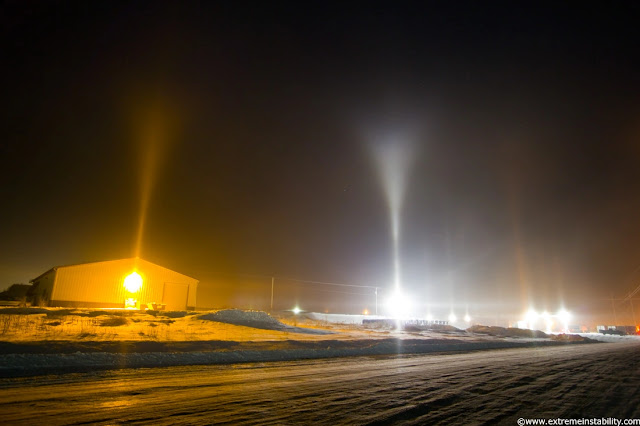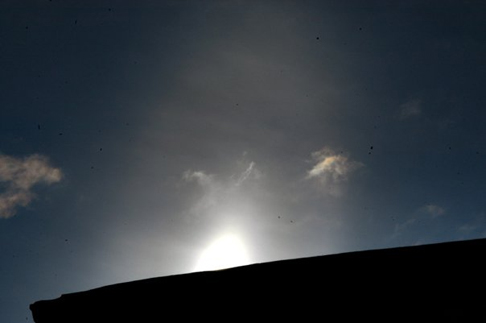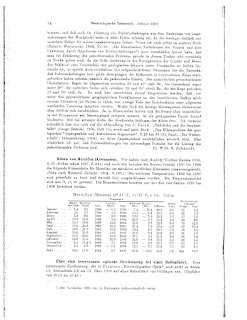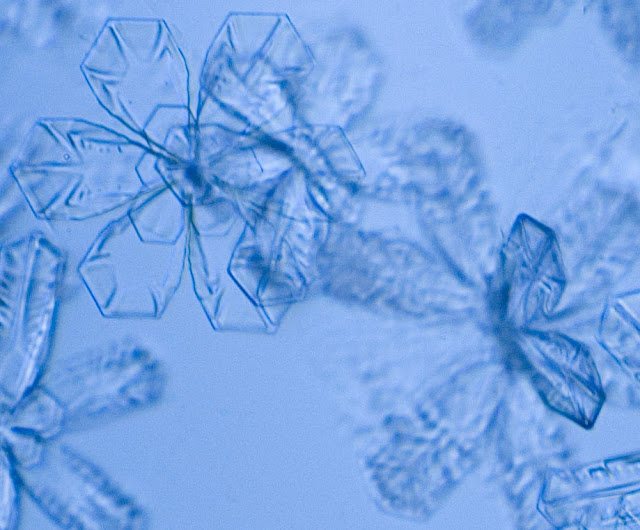Mike Hollingshead photographed these pillars on 26 January 2011 in Blair, Nebraska. The curious thing is that there are two V's above the lamp. Normally only one is seen, the upper tangent arc. While the lower V in Hollingshead's photos is the tangent arc, the upper must be the sunvex Parry arc. Or is it? Lets see if simulations are of any help. Above are two simulations made with Lars Gislen's Streetlight Halo software, which assumes omnidirectional light source. On the right is simulation with column oriented crystals, on the left with Parry oriented crystals. Light source elevation is 2 degrees. The Parry is nothing like the upper arc in Hollingshead's photos, and actually the simulations rather depict what the lower arc should look like. In the lower position Parry and tangent arcs overlap and would be indistinquishable from each other. So, not much help from simulations in identifying the upper arc. But the situation between photos and omnidirectional light simulations is not entirely comparable because even floodlighs give to some extent directed light and this why the upper arc can be seen.
Whathever the upper arc is, it is its classical form, i.e. the form that is similar to what is seen in sun light and which in divergent light situation is formed in crystals near observer. The stronger V below is the divergent light form that shows in Gislen's simulations, made by crystals further away from the observer. The upper arc could be either tangent arc or Parry arc or both, same with the lower arc. The helic arc in two of Hollingshead's images seems to indicate there is Parry population present, so perhaps Parry arc is involved in some way or another. But then again if the lamp is near 0 degrees elevation (the two degrees in the simulation may be overestimate) helic and subhelic arcs overlap, and then the halo would not be sure indication of Parry orientation, because subhelic arc forms also from column oriented crystals. Anyway, usually these displays do have Parry orientation halos and sometimes they even dominate over the column orientation halos.
Mike's photos appeared in Spaceweather.
Friday, 28 January 2011
Double-V above lamps
Thursday, 27 January 2011
Elliptical halo from 22 January 2011
Michael Ellestad
Wednesday, 26 January 2011
Bottlinger's rings
The classical form of rarely observed Bottlinger's rings is an elliptical ring around subsun, sighted normally from an airplane. Their occurrences can be very short, just a couple of seconds. This is because suitable crystal areas are often small and pass swiftly under fast the moving aircraft. Bottlinger's rings have been seen twice also in diamond dust with floodlight as a light source. Formed this way, they look very different from the classical Bottlinger's rings. All together about 10 observations of Bottlinger's rings are known.
Above are shown three cases of Bottlinger's rings. First one is from the book "Clouds of the World" by Richard Scorer, published in 1972. The photographer is not known, the photo was taken near Des Moines, Iowa. The phenomenon is well defined and taking into an account that this is a printed photo, it must have been an impressive Bottlinger to look at. (The book by Scorer is a nice item to have in collection. It has 22 halo photos including the famous black and white "76° halo" photo in the Antarctic by Scorer himself. There are plenty of cheap second hand copies available.)
Second photo shows Bottlinger's ring over Cornwallis Island in the Canadian high artic on 16 April 1999. Leena Virta and I had hitchiked a ride on an airplane that carried supplies to magnetic pole skiing expedition. On a way back we were flying under Ac layer which precipitated ice crystals. Subsun was seen first and I adjusted camera exposure, focus and aperture ready for the Bottlinger, which indeed appeared for about 10 seconds, followed by two other equally brief occurrences. Then the airplane turned so that we lost sight of the subsun, but we were already starting landing to Resolute. It was clear skies in Resolute but luckily the Bottlinger cloud movement was in our direction, and after waiting for a while on the ground, the cloud arrived and elliptical halos were seen around the sun (they were photographed as well, but I can't find those slides right now).
The third case in the above gallery was seen from Yakutsk-Moscow -flight on 3 March 1997, 4 hours and 20 minutes after departure, somewhere over Siberia. We were returning from the Oymyakon halo expedition and all of us three were having window seats. First time the Bottlinger flashed we were sort of asking each other "did you see what I think I saw"? We continued looking and the Bottlinger appeared again, and this time it was better. Jarmo was keeping the camera at the window ready and got a photo, though not from the best moment.
Three explanations have been proposed for Bottlinger's rings. One, suggested by Bottlinger himself, is that plate like crystals fall in pendulum motion. The 1910 article by Bottlinger in Meteorologische Zeitschrift is given above. Second theory is that crystals fall in gyrating mode. This was proposed by Lynch, Gedzelman and Frazer in 1994. A figure depicting the pendulum and gyration motions of the crystals and the resulting simulated Bottlinger's rings from their paper is shown. Third model gives low angle pyramidal crystals as an explanation for Bottlinger's rings. This was brought forward by S. W. Visser in 1961 to explain elliptical halos; in 1999 Sillanpää et. al. extended the idea to Bottlinger's rings.
Now which one is right? I go for the Visser-Sillanpää model although low
pyramid angles are not theoretically favourable. It is the only one
that explains also nicely the elliptical halos. With gyration model
multiple scattering should be incorporated, in which elliptical halos
would be Bottlinger's rings caused by the subsun. Sillanpää et. al. has
shown that elliptical halo shapes and intensities can not be explained
by such a model. There are also other considerations which make the
gyration model weak, but I leave it at that this time.
Monday, 24 January 2011
The Saskatoon halo display
by Marko Riikonen
A handful of halo displays have been of such an impact that they have become known by the location of occurrence or by the observer’s name. The display in Canada’s Saskatoon on 3 December 1970 belongs in that group – it is simply called ‘the Saskatoon display’. This halo complex was of remarkable intensity but its main merit is that it provided the first photographic documentation of parhelia at about 46 degrees distance from the sun. More precisely, they are 44° parhelia, which are the parhelia of exceedingly bright ordinary 22° parhelia. “Secondary halos” and “multiple scattering halos” are the terms that have been used to describe halos formed in such a way.
Thus far, only one photo of the display’s 44° parhelia has been published, printed in black and white in the June 1972 issue of Weather magazine in an article “Unusual arcs in the Saskatoon halo display” by W. F. J. Evans and R. A. R. Tricker. The cover of that issue is shown above, with a photo of the circumzenithal arc from the display. The cover was originally in color but I have only this black and white scan. Shown also is a drawing from another Weather article “Photometeors at Saskatoon on 3 December 1970″ in the 1971 issue 26 by Earle Ripley and Bernard Saugier.
Of the few people who photographed the Saskatoon display, Earle Ripley was watching it at the University of Saskatchewan campus. Above are two photos of the 44° parhelia that Earle send me a couple of days ago after I had contacted him. He gave permission to go ahead with publication on the internet. The photos were taken about 10:30 am, at which time the sun elevation was about 9 degrees. The intensity of the 44° parhelia in those photos is unparalleled. This is made even more remarkable because of the high sun elevation. No other 44° parhelia photos exist for this high a solar altitude. The higher the sun is, the more extensive the diamond dust cloud has to be vertically in order to have enough crystal mass for the formation of the 44° parhelia. The horizontal extent of the diamond dust in 44° parhelia displays is probably always of the order of kilometres.
After Saskatoon, 30 years passed until the next photos of 44° parhelia were taken. Now it appears that we get one photographed case every year. This year's display came from Sweden, last year from Czech Republic. None have been as great as the Saskatoon, but displays of similar magnitude and style certainly recur - at least in the vast uninhabited expanses of polar areas - and one day someone is bound to be around when that happens, hopefully with a camera.
[25 January: The black and white Weather cover was replaced with colored one, thanks for Walt Tape for sending it]
Friday, 14 January 2011
Streelight Bottlinger in Kangasala on 9/10 January 2010
If there is a holy trinity for a halo man, it must be the appearance of streetlight pillar and Bottlinger's ring. The night we saw this with Jari Luomanen we had given alreaydy up the halo hunt at Sappee ski resort and were returning home. But on a way back Jari thought of seeing something resembling 22 tanget arcs in the Kangasala lights and we went to take closer look. It was not tanget arc - the lamp pillar was accompanied by a steep V-figure, of a kind which we had never seen before. We started photographing, although in the beginning we had swells of suspicions of it being just a lamp artefact. However, as the effect later clearly showed on some other lamps, this was not a worry anymore: it was a halo. But what halo, that was not competely clear until later when the halonight was already over.
The stuff formed from nucleating water fog at -16 C. The area where the nucleation took place was perhaps about a square kilometer and within it, only at a small, say, two hundres square meter area was the Bottlinger seen. Elsewhere it was just pillars (the first photo above shows just pillars, but to the right from the photo a Bottlinger was seen constantly from a lamp only about 100 meters away). And outside that water fog was everywhere. Anyway, the Bottlinger was seen in the same spot for 4 hours at the Kangasal industrial area. We drove a bit around returning always to same place.
Some variation can be seen in the photos in the angle of the V when a time lapse movie is made. I took crystal samples and above are plenty of photos of those crystals. For some reason all turned more or less blurry, but one can still make out details of them. Is it only me, or are the branches of many crystals slightly sloping towards the ends? That low angle would provide the reflecting surface for the Bottlinger in horizontal crystals.
Now Bottlinger's ring is just a helic arc from crystal angles that do not deviate much from the horizontal, but in this display there was also another helic arc, as shown by two photos above. This one probably has the same angle as the normal helic arc from Parry crystals. Non-Parry helic arcs are common - they have been seen with only a pillar.


































































